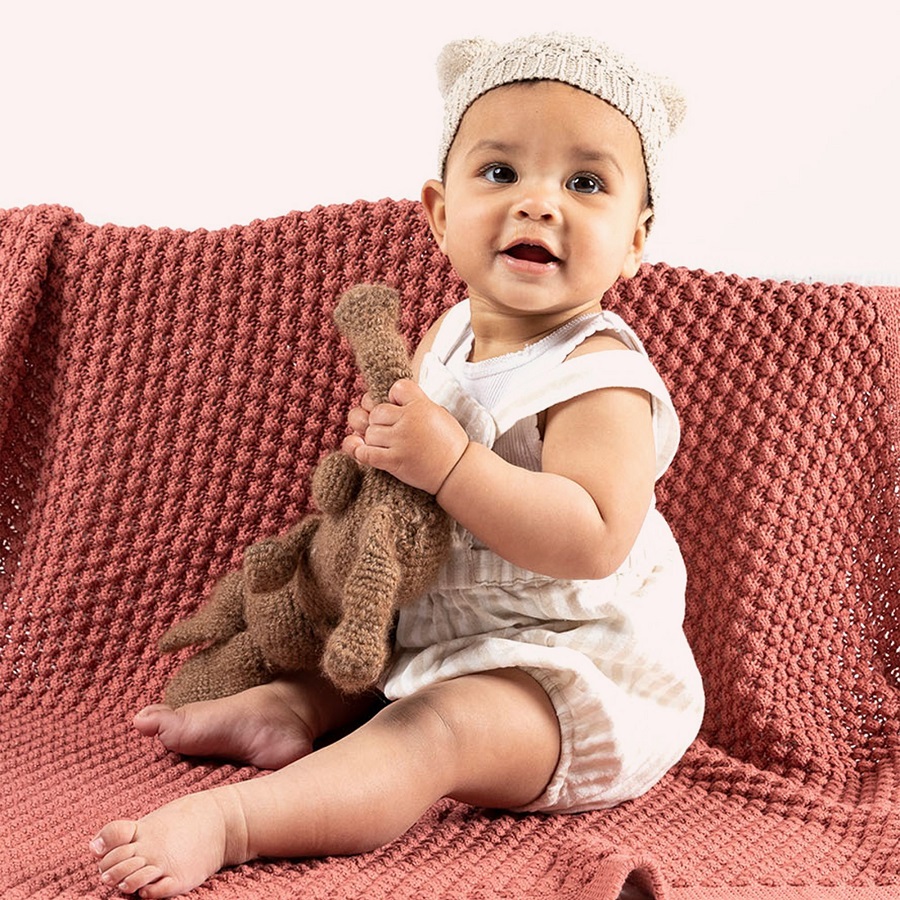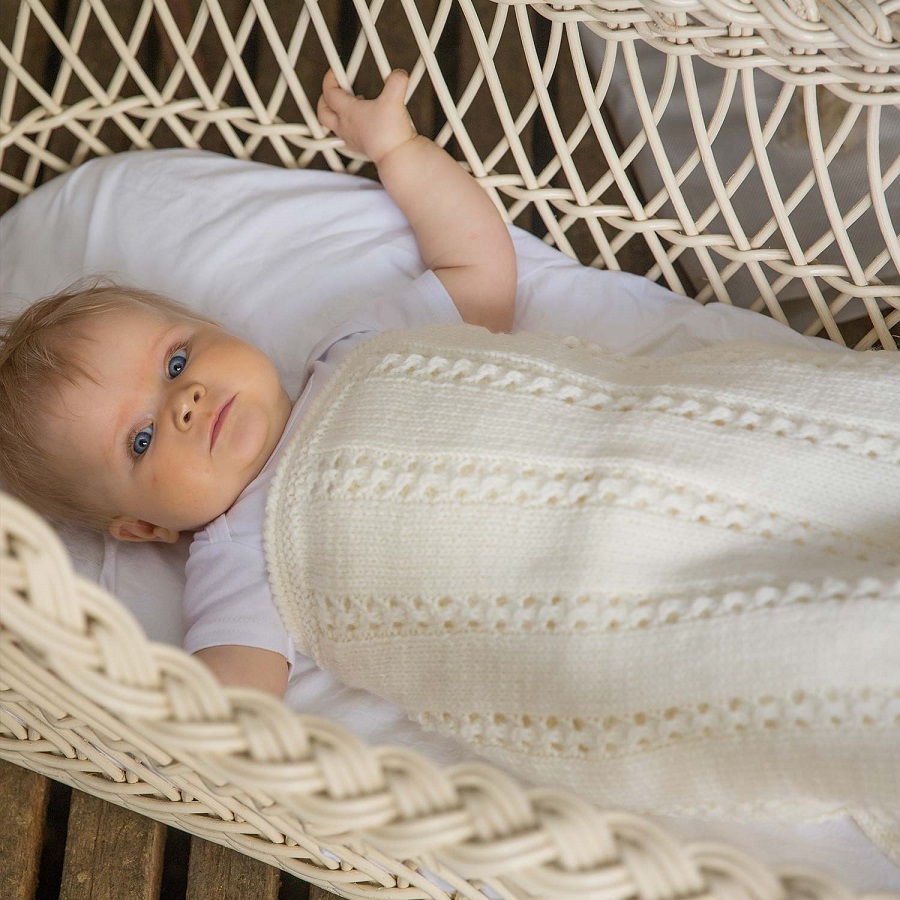Essential Baby Blanket Types
Preemie Blankets
Choosing a blanket for a premature baby is crucial. Preemie blankets should be very soft, and small in size. They provide comfort and warmth to tiny newborns. Sizes can vary, commonly from 18 by 18 inches to 30 by 30 inches.
Receiving Blankets
Receiving blankets are versatile and durable. Made of sturdy cotton, they are used for swaddling, burping, and shielding when outside. They’re often square or rectangular, and sizes range roughly from 30 x 30 inches.
Swaddle Blankets
Swaddle blankets are for snugly wrapping a baby. They prevent self-scratching and offer a secure feeling. Designs and sizes vary, but they often have wings for easy wrapping. A typical size may be around 40 x 40 inches.
Crib Blankets
Crib blankets are for older babies and toddlers. They’re larger, to fit crib mattresses, and provide comfort during sleep. Sizes often depend on crib dimensions, but a common size is 45 x 60 inches.
Multi-Purpose Baby Blankets
These blankets are versatile and larger, serving as swaddles, stroller covers, and play mats. Sizes can be between 40 x 40 inches to 47 x 47 inches, suitable for various uses.
Baby Sleeping Bags
Baby sleeping bags replace loose blankets in cribs. They keep babies warm without the risks of covering their faces. They vary in size based on the baby’s age and are ideal for safe sleep.
Standard Baby Blanket Sizes
Understanding the standard sizes of baby blankets ensures comfort and safety for your child.
Receiving Blanket Standard Dimensions
A receiving blanket is commonly 30 x 30 inches. Small and flexible, it suits many needs.
Swaddle Blanket Sizing
Swaddle blankets range from 40 x 40 inches to 48 x 48 inches. They wrap babies snugly.
Crib Blanket Measurements
Crib blankets vary in size, typically 45 x 60 inches, fitting the crib comfortably.
Stroller Blanket Dimensions
Stroller blankets are around 30 x 40 inches, perfect for on-the-go parents and outdoor use.
Throw Blanket Size
Throw blankets, smaller than bed blankets, usually measure 50 x 60 inches for added style and warmth.
Material Selection for Baby Blankets
Choosing the right fabric for your baby’s blanket is essential. Think about the season and safety. Soft, breathable materials are best for comfort and warmth. Let’s explore smart material choices for different times of the year.
Seasonal Material Considerations
For summer, lightweight cotton or muslin are perfect. They keep babies cool and comfortable. In winter, thicker materials like fleece provide extra warmth. Always select fabrics that suit the climate to keep your baby cozy.
Safety and Breathability
Safety is top priority with baby blankets. Choose breathable fabrics to prevent overheating. Natural fibers like cotton are ideal. They allow airflow and minimize the risk of suffocation.
Allergens and Hypoallergenic Fabrics
If your baby has sensitive skin, hypoallergenic fabrics are important. These fabrics resist allergens and protect your baby. Materials like bamboo are naturally hypoallergenic. They’re soft, eco-friendly choices for baby blankets.
Safe Usage of Baby Blankets
Safe usage of baby blankets is vital for your child’s health and safety. This section provides guidelines to ensure you use baby blankets correctly and avoid common hazards.
Avoiding Overheating and Suffocation Risks
Choosing the right baby blanket involves more than size and material; safety is paramount. To prevent overheating and suffocation:
- Always opt for breathable fabrics like cotton or muslin. These materials allow air circulation.
- Avoid heavy or overly thick blankets that can trap heat.
- Keep the baby’s face uncovered to ensure they can breathe freely.
- Use wearable baby blankets or sleeping sacks, especially for overnight sleep, to maintain a safe temperature.
Guidelines for Use in Cribs and Strollers
Using baby blankets in cribs and strollers requires precaution:
- Ensure the blanket is snugly fitted around the baby to prevent it from bunching up and covering the face.
- Position the baby at the foot of the crib with the blanket securely tucked in, covering only up to the chest.
- Avoid draping blankets over strollers when it’s hot, as this can create a greenhouse effect. Opt for a light mesh cover that provides shade and ensures ventilation.
Special Considerations for Swaddling
Swaddling is a technique used to calm and soothe babies, but it must be done correctly:
- Use swaddle blankets specifically designed for swaddling, which are typically lighter and more breathable.
- Make sure the swaddle is snug but not too tight. It should allow for leg and hip movement to avoid developmental issues.
- Always monitor the baby to ensure they do not overheat.
In conclusion, choosing the right blanket is just the start. Proper usage ensures your baby remains safe, comfortable, and happy.
 Additional Baby Blanket Functions
Additional Baby Blanket Functions
Tummy Time and Play
Baby blankets serve more than one purpose beyond just warmth. They are essential for tummy time, a critical activity for baby’s physical development. During tummy time, a soft yet firm blanket provides a safe and comfortable space for your baby to lay on their stomach. This position helps strengthen their neck, shoulders, and arm muscles, which are important for crawling and other motor skills. Ideally, use a large, multi-purpose or play blanket during these sessions, as they offer enough space and cushioning.
Travel and Outdoor Protection
When traveling or spending time outdoors, a baby blanket becomes a versatile tool. It can shield your baby from sun, wind, and slight weather changes. For car rides and stroller outings, a smaller stroller blanket is perfect. It’s easy to handle and provides just enough coverage without being cumbersome. Moreover, during picnics or visits to the park, a larger blanket can be spread on the ground to create a clean and soft play area, protecting your baby from the grass or sand.
Creative and Heirloom Uses
Baby blankets can also be cherished as keepsakes or turned into creative heirlooms. Some families choose to embroider their baby’s blankets with names or dates, turning them into precious mementos. Others may repurpose smaller baby blankets into quilt patches as the child grows, linking memories and craftwork into a unique family treasure. This thoughtful transformation not only recycles the fabric but also preserves the sweet early memories of your child’s life.
Tips for Choosing the Perfect Baby Blanket
Prioritizing Baby’s Comfort
When picking a baby blanket, comfort comes first. Go for soft, cozy fabrics that feel gentle against your baby’s delicate skin. Look for materials that offer breathability, such as cotton or muslin, to prevent overheating during sleep. The right blanket can help your baby settle faster and sleep better.
Factoring in Growth and Longevity
A smart blanket choice allows room for your baby to grow. To get more use over time, consider larger sizes, like multi-purpose blankets. These adapt to different needs as your baby grows, from a playmat to a stroller cover. Also, pick durable fabrics that withstand frequent washes and daily wear and tear.
Incorporating Personal Style
Choose a blanket that reflects your personal style or nursery theme. From colourful patterns to soothing neutrals, select a design that brings you joy. A blanket isn’t just practical; it’s part of your baby’s world. Picking one that complements the room adds a touch of personality to your baby’s space.
Caring for Your Baby’s Blanket
Proper care for your baby’s blanket ensures its longevity and maintains its comfort. Understanding how to wash and maintain the blanket is crucial.
Washing and Maintenance
To keep the baby blanket in top condition, follow these tips:
- Always check the care label before washing.
- Use a gentle, baby-friendly detergent.
- Wash in cold water on a delicate cycle to prevent shrinkage.
- Avoid bleach or fabric softeners as they can irritate baby’s skin.
- Tumble dry on low heat or air dry if possible to preserve the fabric’s softness.
The right washing technique can keep the blanket soft, clean, and safe for your baby’s delicate skin.
Preserving Size and Shape
Maintaining the size and shape of a baby blanket is important:
- Avoid high heat in washing and drying as it can shrink the fabric.
- If hand-washing, gently squeeze the water out instead of wringing the blanket.
- Lay the blanket flat to dry to maintain its shape.
- Store the blanket properly by folding it or rolling it to avoid creases.
By carefully handling washing and storage, your baby’s blanket can remain plush and welcoming, becoming a comforting presence in their daily routine.
